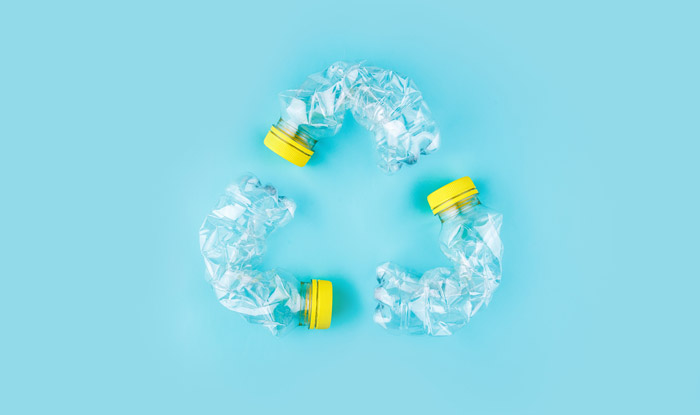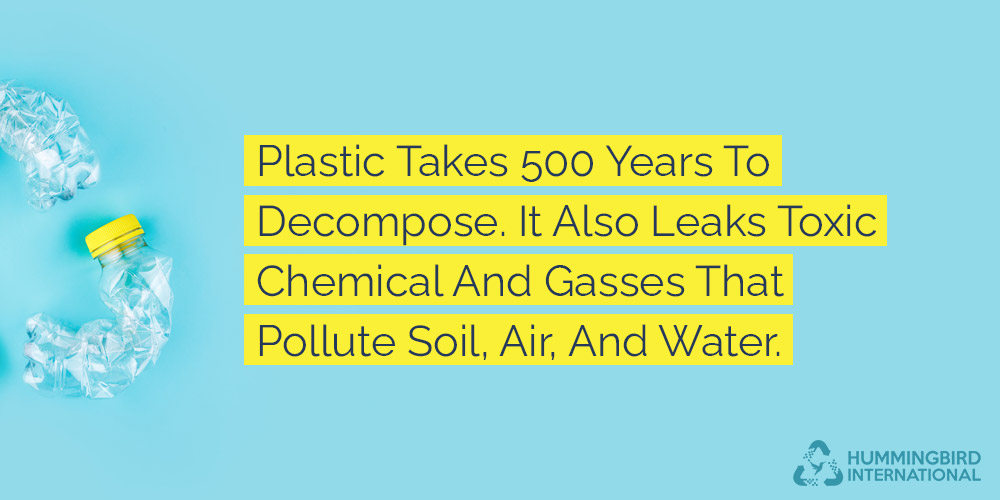The Myth Of Plastic Recycling: What Really Happens To All The Single-Use Plastic?

Photo Credit: iStock/xmocb
Through a well-coordinated campaign of misinformation and propaganda, the plastics industry has successfully hoodwinked the society into believing that plastic is a recyclable material.
The fact is, plastic has an insufferable long lifespan of over 400 years. It’s not easy to get rid of. In fact, doing so is quite toxic, expensive, and hazardous for the environment.

Plus, the same industry, along with its manufacturing clients, has convinced consumers that getting rid of single-use-plastic products is the responsibility of consumers, not the manufacturers.
The manufacturers keep producing millions of plastic products every year and take no responsibility for disposing of them correctly.
The result is a broken down system that’s quickly choking up our oceans, polluting our soil, and poisoning the air we breathe.
The Facts that Expose the Lie
Here are some statistics that tell you how plastic recycling has always been largely a myth, and never actually worked.
- Of the 8.3 billion metric tons of plastic produced since the 1950s, only 9% has been recycled so far. The major portion — 79 percent — has been sent to landfills, littered, or incinerated.
- The amount that has been recycled has produced little enough new products. Estimates from the advocacy group Beyond Plastics suggest that only 5-6% of US plastic waste has been turned into new products in 2021.
- What’s more, we are producing even more plastic. The new plastic is of higher quality and much cheaper, so consumer product groups are buying more new plastic. Statista reports that by 2050, global plastic production will rise by 30%.
- Just because a plastic product has the recycling mark on it doesn’t mean it can actually be recycled. According to a recent report by Greenpeace, only some PET #1 and HDPE #2 bottles and jars can accurately be labeled as recyclable, as they can be recycled and turned into new containers. The rest cannot.
- China has stopped accepting plastic waste sent by the U.S. The local infrastructure that we currently have is not efficient and ill-equipped to handle most kinds of plastic recycling. Meaning, most recyclers are sending even recyclable plastics to landfills as they cannot handle the capacity overflow.
- Recyclable plastic needs to be thoroughly washed and accurately sorted by consumers. Even only a little amount of product residue left on the plastic can render it non-recyclable. So, unless you are thoroughly washing each plastic bottle and religiously sorting it, your recycling efforts are not putting a huge dent into this behemoth crisis.
Is Plastic Really That Bad?
It’s okay to wonder about that. Because plastic as a material is strong, durable, and easy to produce. It’s also incredibly inexpensive, and costs little to manufacture. Products wrapped and packaged in plastics last for long, and survive a variety of traveling conditions to reach their destinations.
Yet, this longevity and durability is also the reason that plastic is a harmful substance. You cannot make it disappear easily. Most types of plastic products that exist today cannot be recycled or turned into nothing, no matter what you try.
Plastic stuff that can be recycled requires an incredible amount of resources — energy, money, water, infrastructure, and more — to fully transfer into other, newer products. But since new plastic products are always of higher quality and cheaper than recycled plastic, it’s not financially viable to recycle plastic at all.
If we give up recycling and start throwing it in landfills, it’ll take 500 years to decompose. In that time, it’ll potentially leak harmful chemicals and toxic gasses that’ll pollute our soil, air, and water.

If we incinerate it, burn it, what then? Will it solve anything?
Unfortunately, no. Burning plastic releases a ton of harmful greenhouse gasses that are even more dangerous to earth and human life than dumping the lot in landfills. When we burn plastic, dioxins are released, plus heavy metals, and harmful particles, things that cause cancer and damage the immune system.
According to a research cited by Greenpeace, chicken eggs at the distance of only 2 KM (7.45 miles) from a modern incinerator contained such high levels of dioxins that they were unfit for human consumption.
So, no, burning plastic waste is not a viable solution either.
more. Every day. To reduce the trash in landfills and address the plastic problem, we have to think of something else.
But what? How do we deal with the plastic crisis? Is there no solution?
The Solution To The Plastic Crisis
The plastic crisis may be a monstrous issue, but it’s one that can be solved. In addition to recycling what can be recycled, some immediate and innovative solutions can be put in place that reduce our dependence on plastic, and phase it out of our lives gradually.
Few of them are listed here.
1. Legislate against single-use plastics
Emboldened by huge public support — with 88% of consumers in favor — Governments around the world have introduced bans against single-use plastic products. These products include takeaway containers, plastic cutlery, disposable cups, balloon sticks, cotton buds, and many more.
Businesses and organizations are being banned from selling, supplying, distributing, or in any other way using single-use plastics. By introducing these bans, governments not only aim to reduce plastic pollution but also discourage their further production by curbing demand.
2. Pay people to bring back single-use-plastic bottles/containers
In many corners of the world, plastic recycling rates are being improved by paying people to bring back their plastic trash to the shops or designated vending machines (reverse vending machines, where you feed the machine your plastic trash).
The Plastic Bank, a Canadian social enterprise, is turning plastic into a valuable currency in impoverished parts of the world. In countries like Indonesia, Brazil, and Philippines, people collect their plastic waste, bring it back to shops, and get paid in cash or credit. This incentivizes people to clean up plastic trash from their homes and streets, and in doing so, earn money to fulfill their needs.
3. Switch to systems of reuse and refill
Reuse and refill systems refer to business and consumer practices that increase the amount of times a plastic product can be used.
By extending the usage cycle of a plastic product, we can ensure that it doesn’t end up in trash anytime soon, and doesn’t become a reason to choke up the planet. In December 2022, 175 governments met under the umbrella of the UN to initiate a legally-binding plastics treaty that aimed to reduce and eventually end the global crisis of plastic pollution.
The governments in that session agreed that only a system of reuse and refill can help sustain the vision of the plastic-free world.
By offering consumers to refill their shampoo bottles, tea containers, soap dispensers, and other daily item needs, we can drastically reduce our single-use plastic consumption. And by creating durable packaging items and other containers that can withstand multiple cycles of reuse, we can keep a plastic product in circulation for much, much longer, reducing the load on environmental resources.
4. Invest in plastic alternatives
Plastic has become so pervasive, so omnipresent in our daily lives that we don’t even question if there are other, better ways to live and consume.
But the fact is that plastic is actually quite new. Before 1950, prior to plastic becoming a pass-produced item, so many of us were living our lives using products made of glass, stainless steel, wood, bamboo, silicone, and other materials. These materials are durable, strong, friendly to the environment, and are aesthetically-attractive too. One of the most effective packaging that stayed with us till today is eco-friendly kraft boxes. They are made with durable brown kraft paper that is easy to recycle and biodegradable material, which makes them a great alternative to plastic packaging.
And we can return to them now. Sure, it’ll take a bit of adjustment, but it’s important to remind ourselves that there are incredibly eco-friendly ways to package our products, consume our takeaway food, decorate our houses, carry our stuff, and live our lives.
By relying more and more on plastic alternatives, such as plant-based plastics, sustainable materials, and reusable innovations, we also bust the myth that modern life cannot sustain without the durability of plastic. It will, and it’s the only way it can.
5. Think of inventive methods
All the things we have listed here are the things that people are already doing in the world. These are the plastic-free steps that we know work and can be scaled.
Yet, there are inventors and researchers and scientists who are wading deep into the waters and coming up with insightful solutions to the plastics problem.
A team of microbiologists from Pakistan, for example, have zeroed in on a species of fungus that secretes a special enzyme that degrades plastic, and gets its food from the dissolving plastic. Growing this fungus — Aspergillus tubingensis — in landfills can be a novel solution to get rid of all that plastic in landfills.
Additionally, plastic can also be recycled to build new roads. In the Netherlands, a bike path in the city of Zwolle has been constructed using recycled plastic packages, bottles, cups, and such. The company that has built the road claims the material is more durable than asphalt and requires less time and less heavy equipment to install.
The whole thing not only uses plastic trash and makes it purposeful, but does it in a way that’s even friendlier to the environment by having a smaller carbon footprint.
Conclusion
The moment to create a plastic-free world is now. The pace at which plastic production has accelerated is so disastrous that estimates suggest pretty soon the plastic weight in our oceans will match the weight of the fish in the seas, ton for ton.
Therefore, it’s imperative to not look at plastic recycling as the ultimate solution to the problem. It’s not. If anything, it’s only a small part of a diverse, and comprehensive service pack we need to really obliterate this crisis once and for all.
By investing in the solutions, we have discussed here and taking the lion’s share of the responsibility in the expansion of the problem, the plastics industry can begin to right the wrong it created 70 years back.
To nudge them on, consumers ditching single-use plastics, and governments putting unflinching bans against it, are some of the immediate steps we can count on.
About The Author Kelly Sampson
Kelly Sampson is a writer, blogger, and environmental enthusiast. She has strong opinions about climate change, the dogs vs. cats debate, and Oxford commas. She has lent Hummingbird International her engaging and spirited voice and turned our blog into a great place to find valuable information about e-waste, e-waste recycling, and the ITAD industry. Explore our blog to read more of her work.






